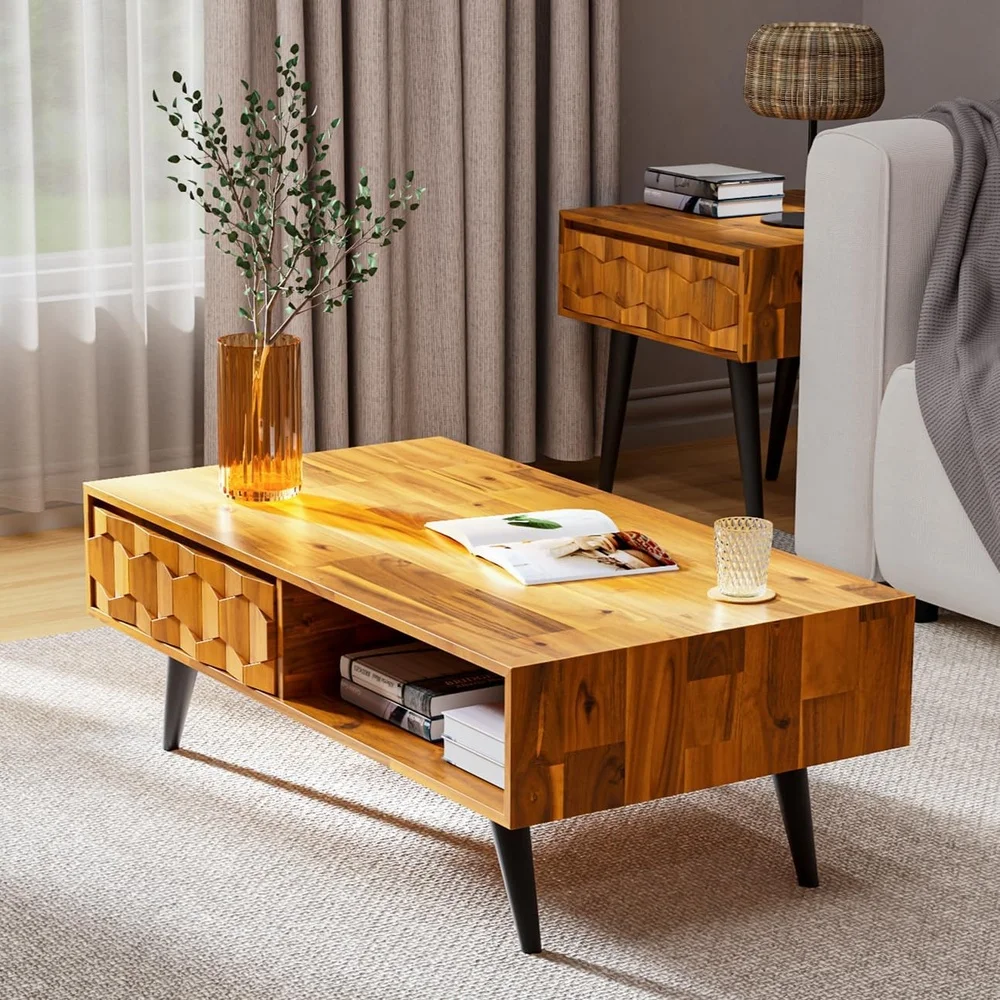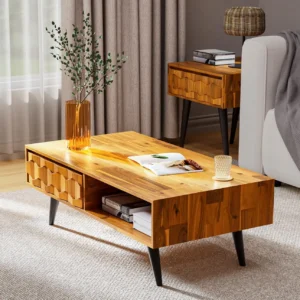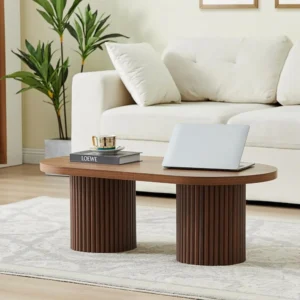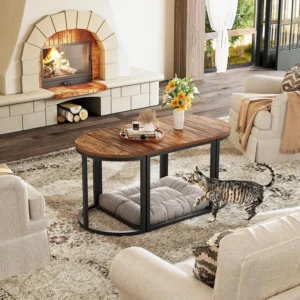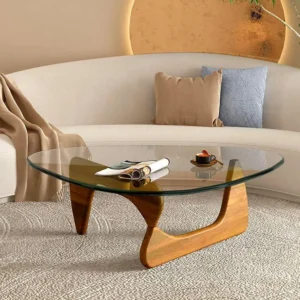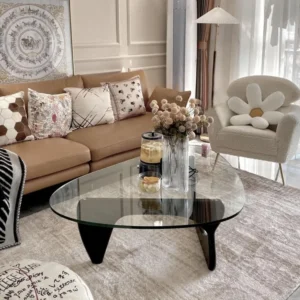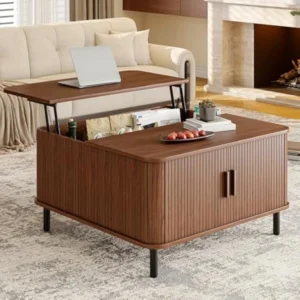The Enduring Appeal of Teak Wood in Coffee Table Design
Few materials in furniture design have maintained their allure quite like teak. This remarkable hardwood stands apart from other materials thanks to its exceptional natural properties that make it ideal for creating lasting furniture pieces. Teak’s remarkable durability comes from its dense grain structure and high natural oil content – approximately 7% – providing built-in moisture resistance that few other woods can match. This inherent protection means teak naturally resists warping, cracking, and pest infestation without chemical treatments.
What truly sets teak apart in the world of iconic furniture pieces is its extraordinary aging process. Unlike woods that deteriorate with time, teak develops a distinguished silvery-gray patina that many designers and homeowners prize. This transformation happens gradually as the wood’s surface interacts with air and sunlight, creating a living material that gains character and depth as it matures.
Teak’s journey into Western furniture design began with its origins in the dense forests of Southeast Asia, where it was prized for shipbuilding due to its exceptional weather resistance. By the mid-20th century, teak had become the cornerstone material for progressive furniture designers who valued both natural beauty and practical durability. The natural properties of teak made it the perfect canvas for designers who wanted to create pieces that would last for generations while maintaining their visual appeal.
Coffee tables, as central pieces in the modern living room, became perfect showcases for teak’s unique qualities. The medium scale of these tables allowed designers to highlight teak’s warm honey tones and distinctive grain patterns while demonstrating the wood’s ability to be shaped into both geometric and organic forms. This versatility, combined with teak’s practical benefits, established the teak coffee table as more than just furniture – it became a design statement that continues to resonate in contemporary interiors.
The Mid-Century Modern Revolution: When Teak Coffee Tables Became Icons
The period from 1945 to 1975 marked a design revolution that would forever change how we think about home furnishings. Mid-Century Modern design emerged as a response to the post-war world’s changing values and lifestyles. This design movement emphasized clean lines, minimal ornamentation, and a seamless flow between indoor and outdoor living spaces. The philosophy prioritized function without sacrificing beauty, creating pieces that were both practical and visually striking.
Scandinavian influence played a crucial role in elevating teak furniture to iconic status. Danish, Swedish, and Finnish designers brought a particular sensibility that emphasized craftsmanship, natural materials, and human-centered design. The Scandinavian influences on furniture design championed the idea that everyday objects should be both beautiful and accessible – not just luxury items for the wealthy. This democratic approach to design perfectly aligned with teak’s properties and availability.
Several core principles defined the Mid-Century approach to mid-century modern coffee tables that would become classics. “Form follows function” meant that design decisions served practical purposes rather than mere decoration. “Truth to materials” celebrated the natural characteristics of materials rather than disguising them. These philosophies led to teak coffee tables that showcased the wood’s natural grain and color while featuring thoughtful, purpose-driven designs.
As American homes embraced open floor plans, coffee tables took on new importance. No longer just subsidiary pieces, they became focal points in living spaces – functional sculptures that anchored rooms while serving daily needs. The teak coffee table, with its warm tones and versatile design possibilities, perfectly filled this role. This centrality helped elevate these pieces from simple furniture to design icons that would be celebrated for decades to come.
Design Signatures: Silhouettes That Defined an Era

The silhouette of a teak coffee table – its overall shape and proportions – often provides the first visual impression and defines its character. During the mid-century period, designers explored diverse forms that balanced artistic expression with practical function, creating profiles that remain instantly recognizable today.
Rectangular mid-century modern designs became classics for their versatility and efficient use of space. These tables typically featured balanced proportions with length-to-width ratios of approximately 2:1, creating pieces that provided ample surface area while maintaining visual harmony. The rectangular format allowed designers to showcase the natural grain patterns of teak while creating pieces that could serve as anchors in various seating arrangements.
Perhaps the most innovative contribution to coffee table design during this period was the introduction of organic or biomorphic shapes. These free-form silhouettes – often described as kidney, amoeba, or surfboard shapes – brought sculptural elements into everyday living spaces. By mimicking forms found in nature, these tables softened the geometric hardness of many interiors while creating conversation pieces that felt both playful and sophisticated.
For those seeking more structured yet non-traditional options, oval-shaped mid-century modern coffee tables offered an elegant alternative. These designs eliminated sharp corners while maintaining a clear directional emphasis, making them particularly well-suited to elongated living spaces. The gentle curves of oval tables created a sense of movement while providing practical surface area.
Round coffee table options became another significant silhouette category, often found in smaller spaces or as part of nesting sets. These circular designs promoted conversation by allowing equal access from all sides while creating a sense of flow in the room. The perfect circle represented mathematical precision while still feeling approachable and warm when executed in teak.
The influence of these pioneering silhouettes extends far beyond their original era. Contemporary furniture designers continue to reference and reinterpret these forms, recognizing that their appeal transcends passing trends. These shapes work because they balance aesthetic concerns with human needs – the fundamental principle that makes design truly timeless.
The Art of the Edge: Distinctive Profiles and Borders
Though often overlooked, the edge treatment of a teak coffee table plays a crucial role in defining its character and visual weight. These seemingly small details reflect both aesthetic choices and practical considerations, often revealing the designer’s approach to balancing form and function.
Beveled edges became a signature detail on many iconic teak tables. By removing material at an angle (typically between 30-45 degrees), designers created a visual lightness that made substantial pieces appear to float. This technique also softened potential impact points, making these tables more compatible with active family homes while maintaining clean geometric lines.
For designers seeking maximum precision and visual sharpness, knife-edge profiles represented the pinnacle of craftsmanship. These edges taper to an extremely thin point (often just 1/4 inch or 6mm), creating a sense of impossibly delicate woodworking that showcases the skill involved in working with teak. These edges catch light differently than squared profiles, creating subtle shadow lines that change throughout the day.
Rounded and bullnose edges offered a different sensibility, embracing teak’s natural warmth with soft, approachable contours. These treatments involved careful sanding to create uniform curves, often with radii between 1/4 to 1/2 inch (6-12mm). Beyond their visual softness, these edge profiles proved practical for households with children, eliminating sharp corners while maintaining design integrity.
Some of the most distinctive teak coffee tables feature raised edge detailing – borders that contain items and create visual framing for the main surface. These edges, typically raised between 1/2 to 1 inch (12-25mm), serve the practical purpose of preventing items from sliding off while creating a more defined visual boundary for the tabletop. The styling options for these tables often highlight these distinctive edges as key design features.
These varied edge treatments demonstrate the thoughtful attention to detail that elevated mid-century teak coffee tables from mere furniture to design classics. Far from arbitrary decoration, each edge profile served both aesthetic and functional purposes, contributing to the holistic design language that made these pieces endure.
Structural Poetry: Iconic Base and Leg Designs
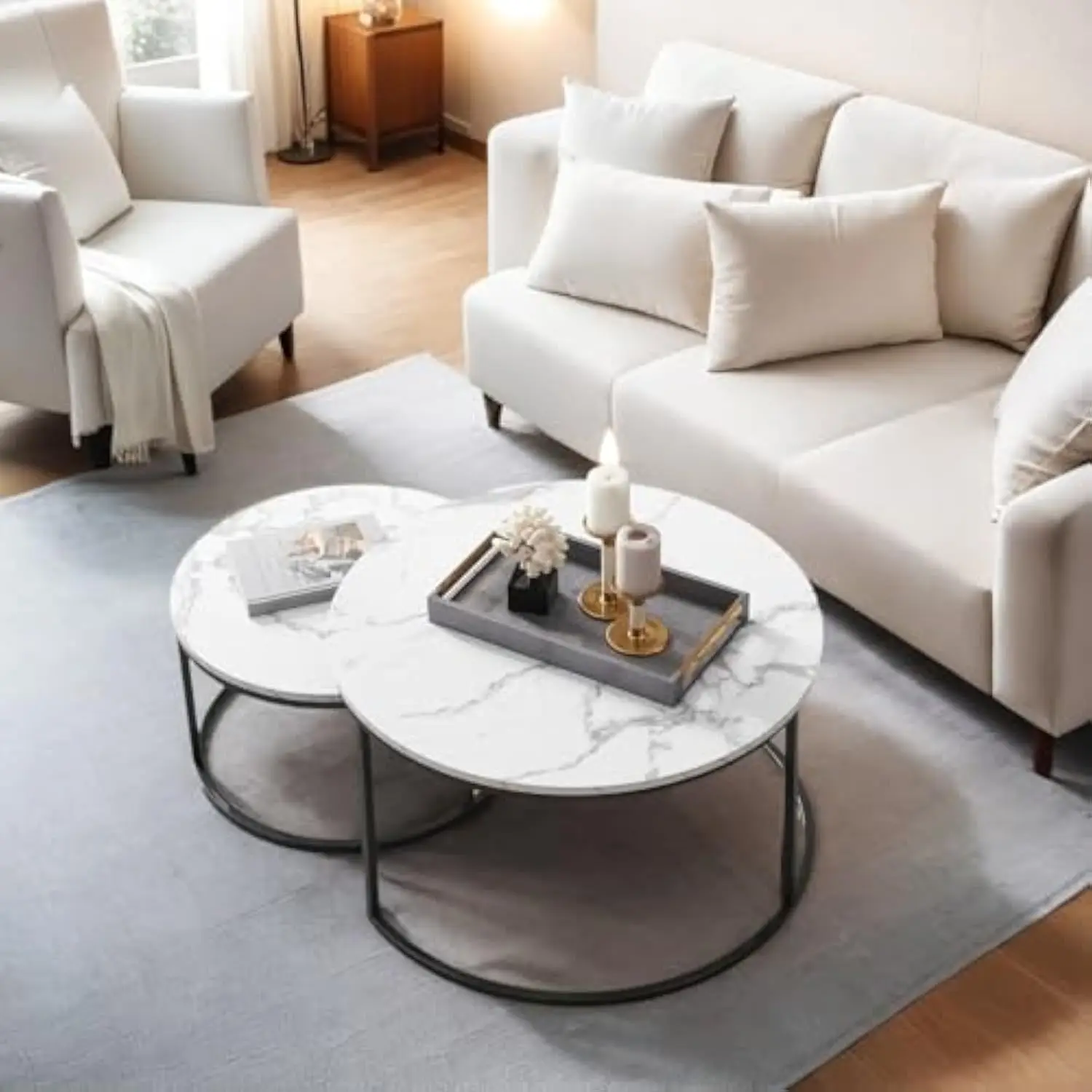
The support structures of iconic teak coffee tables often become their most recognizable features, combining engineering necessity with artistic expression. These elements not only provide physical stability but also create the visual rhythm and dynamic tension that define a table’s character.
Tapered legs represent perhaps the quintessential mid-century feature, narrowing gracefully from top to bottom (typically from about 2 inches to 1 inch, or 50mm to 25mm). This subtle shaping creates visual lightness and elegance while efficiently distributing weight. The precise angle of the taper – usually between 2 to 4 degrees – required careful craftsmanship and contributed to the refined proportions that characterized the best Danish coffee tables.
Splayed legs added another dimension of visual energy to teak coffee tables. Angled outward from the tabletop (usually between 15-20 degrees), these legs created a sense of dynamic tension while providing enhanced stability. The splayed position distributed weight over a wider footprint, making these designs both visually striking and structurally sound – a perfect embodiment of form following function.
Some designers took leg design into more sculptural territory, creating organic, asymmetrical, or highly carved supports that functioned as artistic statements. These more expressive elements demonstrated teak’s exceptional carving properties while challenging conventional ideas about furniture structure. Such pieces often became the centerpieces of living rooms, admired as much for their artistic merit as for their practical function.
Sled and runner bases offered a different approach, using continuous support structures that created visual flow while providing exceptional stability. These bases, typically constructed from solid teak pieces about 1 to 1.5 inches (25-38mm) thick, created a sense of groundedness and permanence. The smooth, unbroken lines of these bases also showcased the beautiful grain patterns that made teak so prized.
Perhaps the most visually striking approach was the floating top, where designers minimized connection points between the surface and base to create the illusion of a hovering tabletop. This technique required precise engineering and joinery, often using hidden metal supports or ingeniously designed wooden connections. The resulting visual tension became a hallmark of black mid-century tables and other sophisticated designs.
Material Harmony: Surface Treatments and Mixed Media
While solid teak coffee tables have undeniable appeal, many iconic designs explored creative combinations of materials to enhance both function and visual interest. These thoughtfully integrated elements created textural contrasts and expanded the practical capabilities of coffee tables without compromising their essential character.
Glass elements became popular additions to many teak designs, creating glass top coffee tables that offered several advantages. Clear glass provided protection for the wood surface while maintaining visibility of beautiful grain patterns below. Smoked or tinted glass added sophisticated color accents while creating interesting light effects. These glass elements were typically 3/8 to 1/2 inch (10-12mm) thick, substantial enough for durability while maintaining a sense of lightness.
For more dramatic material contrast, some designers incorporated stone elements into teak frames. Marble top coffee tables offered heat resistance for hot beverages while introducing luxurious visual and tactile variation. The juxtaposition of warm wood tones against cool marble created a balanced tension that appealed to sophisticated design sensibilities. The weight difference between these materials presented engineering challenges that led to innovative structural solutions.
Tile inlays represented another creative mixed-media approach. Often using 4×4 inch (10×10cm) ceramic tiles in geometric patterns or solid colors, these inlays protected surfaces from heat damage while adding decorative elements. The precise installation of these tiles demonstrated the attention to detail that characterized quality mid-century furniture, with perfectly flush surfaces and carefully considered grout lines.
Metal accents – typically brass, steel, or copper – added both structural support and visual punctuation to many iconic designs. These elements might appear as leg ferrules (protective end caps), connecting hardware, or decorative inlays. The contrast between metal’s cool precision and teak’s organic warmth created a pleasing tension that enhanced both materials.
The finish treatments applied to teak also varied significantly, each creating different aesthetic effects and maintenance requirements. Oil finishes penetrated the wood to enhance its natural color while allowing it to develop a patina over time. Lacquered finishes sealed the surface completely, preserving the original appearance while providing maximum protection. Some designers even explored techniques like cerusing (liming) to highlight grain patterns by filling them with contrasting materials.
Functional Artistry: Storage Solutions and Multi-Purpose Design
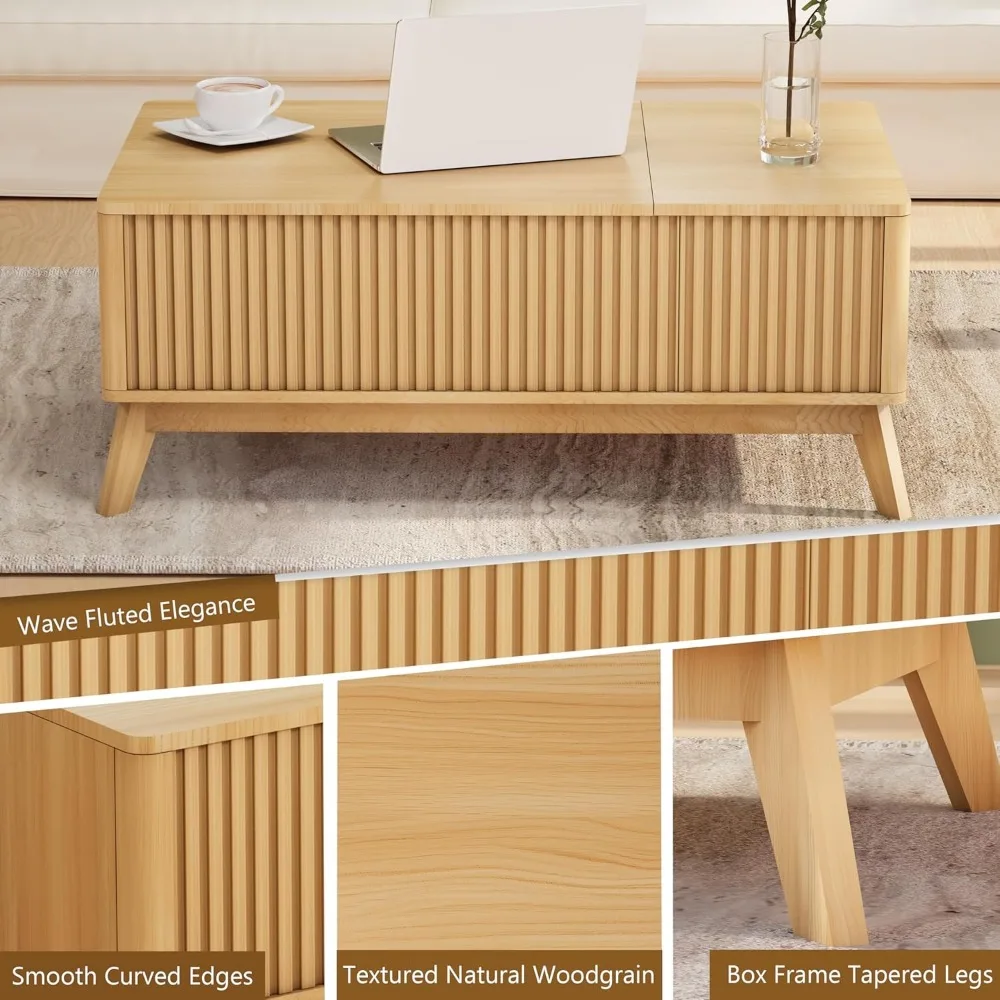
The most innovative teak coffee tables transcended simple surface functionality to address multiple needs through clever integrated features. These thoughtful additions reflected the mid-century commitment to combining beauty with utility in ways that enhanced daily life.
Magazine shelves became a signature element in many iconic designs, responding to the growing importance of magazines in mid-century culture. These shelves, often featuring slatted construction with gaps of approximately 3/4 to 1 inch (19-25mm), allowed visibility of covers while maintaining organization. The slightly angled orientation of many of these shelves (typically 10-15 degrees) made browsing easier while creating visual dynamism in the overall design.
Integrated drawers provided discreet storage while maintaining clean lines. These drawers, typically 3-4 inches (7.5-10cm) in height, offered perfect spaces for storing small items that might otherwise create visual clutter. The quality of drawer construction – featuring smooth-sliding mechanisms and dovetail joinery – often distinguished premium pieces from mass-market imitations.
Lift-top coffee tables represented perhaps the most innovative functional development, allowing height adjustment for dining or working. These ingenious mechanisms, sometimes using counterweights or gas pistons, transformed tables from conversation pieces to workspace surfaces. The engineering challenges of creating stable, reliable lifting mechanisms led to creative solutions that became signature elements of certain designers’ work.
Nesting tables offered space-saving solutions while providing flexibility for entertaining. Typically designed as sets of two or three tables of graduating sizes, these pieces could be compact when not needed or expanded to serve multiple guests. The careful proportional relationships between nested tables (usually with approximately 2-inch or 5cm height differences) demonstrated the mathematical precision underlying these seemingly simple designs.
Some of the most thoughtful designs featured compartmentalized surfaces with designated areas for specific items – sections for drinks, ashtrays (reflecting the era’s different social habits), or display objects. These intentional divisions created visual organization while guiding the use of the table in subtle ways. This approach to functional features in mid-century tables reflected the growing emphasis on casual living and entertaining at home.
The Craft Behind the Icon: Joinery and Construction Excellence
What truly separates iconic teak coffee tables from ordinary furniture is the exceptional craftsmanship evident in their construction. The woodworking techniques employed in these pieces not only ensured their longevity but also revealed the philosophy and values of their creators.
Dovetail joints represent perhaps the most recognized mark of quality in teak furniture construction. These interlocking connections, typically spaced 3-4 inches (7.5-10cm) apart in drawer construction, provide exceptional strength while creating a visual rhythm of interlocking patterns. Beyond their functional superiority, dovetails signaled a commitment to traditional craftsmanship in an era increasingly dominated by mass production techniques.
Finger joints offered another approach to creating strong, visually interesting connections. These interlocking rectangular projections provided substantial gluing surface area while creating a distinctive geometric pattern. When used in visible areas, these joints transformed structural necessity into decorative elements, embodying the mid-century principle that functional elements could also be beautiful.
Mortise and tenon connections – where a projecting piece (tenon) fits precisely into a corresponding cavity (mortise) – created nearly invisible strength in critical stress points like leg attachments. The precise fit of these joints, often with tolerances of less than 1/64 inch (0.4mm), demonstrated the exacting standards of solid wood coffee tables from this period. These traditional joinery methods eliminated the need for visible hardware while providing exceptional durability.
Frame and panel construction addressed one of the greatest challenges in working with natural wood – accounting for seasonal expansion and contraction. By creating floating panels within more stable frames, designers allowed the wood to move slightly with humidity changes without compromising structural integrity. This thoughtful approach prevented the cracking and warping that plagues lesser-quality wood furniture.
Book-matched veneers showcased another level of material appreciation and craftsmanship. This technique involves slicing a single piece of wood and opening it like a book to create mirror-image patterns. The careful alignment of these matched sections created stunning symmetrical grain patterns that turned tabletops into natural art pieces. When executed with precision, these matched patterns flow seamlessly across the surface, creating a cohesive visual experience.
These construction details do more than ensure physical longevity – they reveal a philosophy of furniture making that values integrity, thoughtfulness, and respect for materials. When highlighting quality construction details, these elements become part of the aesthetic appreciation of these pieces, not just technical considerations.
The Masters Behind the Masterpieces: Influential Design Philosophies
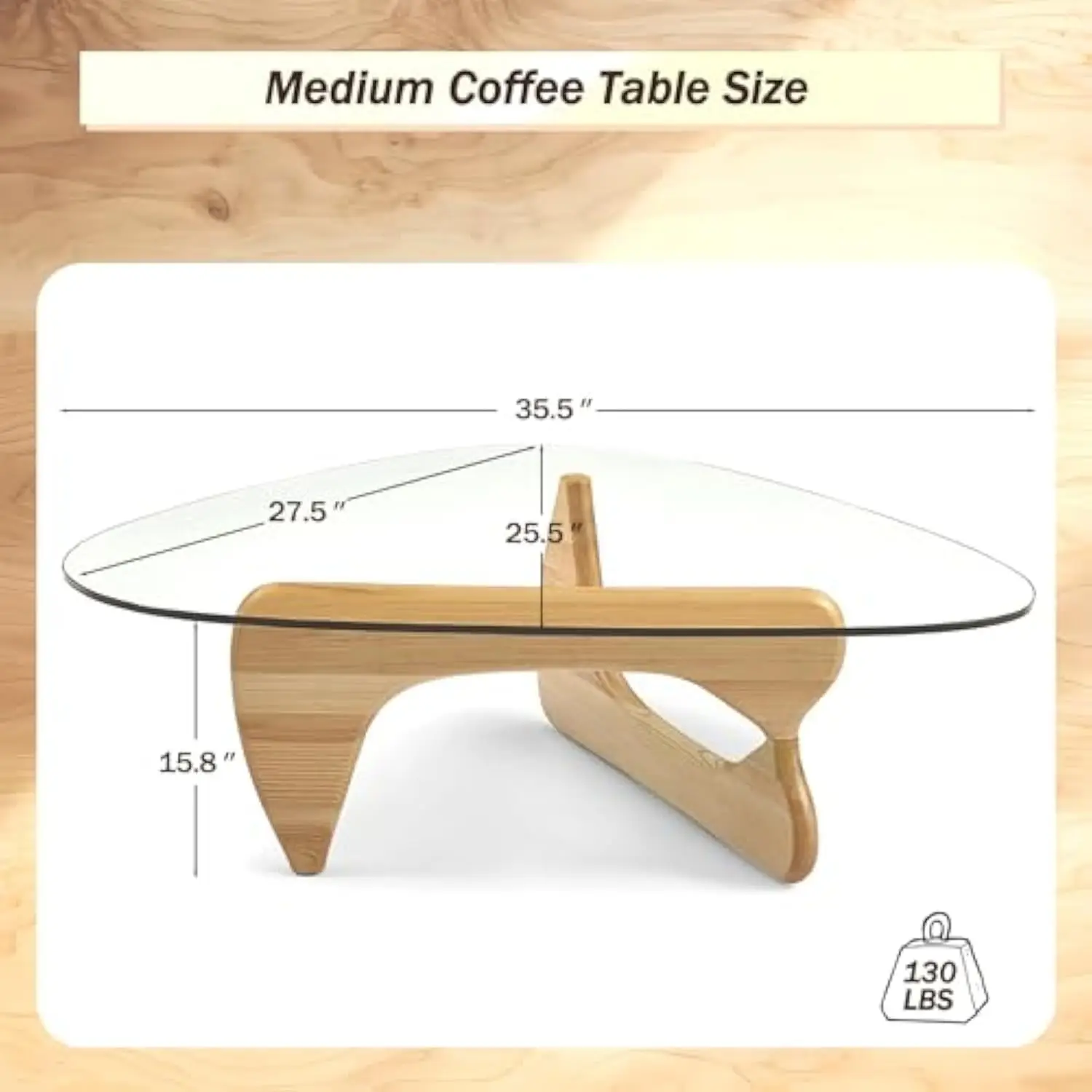
While each iconic teak coffee table has its own distinctive character, these pieces emerged from broader design philosophies that shaped their creators’ approaches. Understanding these foundational perspectives helps explain why certain elements appear consistently across different iconic pieces.
Organic modernism sought to balance clean geometric precision with natural forms and materials. Designers working in this tradition created pieces with flowing lines and biomorphic shapes while maintaining functional clarity. Their teak coffee tables often featured curved or asymmetrical elements that referenced natural forms while still embracing modern production capabilities. This approach created pieces that felt simultaneously progressive and timeless, technological and natural.
The minimalist perspective prioritized material quality and proportional harmony over decorative elements. Designers in this tradition created pieces of striking simplicity, allowing teak’s natural beauty to become the primary visual element. Their coffee tables often featured perfectly balanced proportions, precise joinery, and carefully considered negative space. This restraint required exceptional quality materials since there were no decorative elements to distract from any imperfections.
Democratic design principles sought to make good design accessible to broader audiences without compromising quality. This approach focused on efficient production methods that maintained design integrity while reducing costs. The resulting teak coffee tables often featured clever construction techniques that minimized material waste and labor-intensive processes while preserving essential design elements. This philosophy helped spread iconic design beyond elite markets, transforming how average consumers thought about home furnishings.
The functional art perspective rejected the false dichotomy between useful objects and beautiful ones. Designers working from this viewpoint created coffee tables that served practical needs while functioning as sculptural elements within living spaces. Their pieces often featured unexpected forms, innovative material combinations, or interactive elements that engaged users both practically and aesthetically. This approach elevated everyday furniture to artistic significance without sacrificing utility.
These varying philosophical approaches to design created rich diversity within the world of iconic teak coffee tables, while sharing fundamental values of quality, integrity, and thoughtfulness. The compatible design philosophies continue to influence contemporary furniture design, demonstrating the enduring relevance of these foundational ideas.
Why These Elements Endure: The Psychology of Timeless Design
The staying power of iconic teak coffee tables goes beyond aesthetic appreciation or collectibility – these pieces connect with fundamental human needs and perceptions in ways that transcend passing trends. Understanding these psychological dimensions helps explain why these designs continue to resonate decades after their creation.
Human-centered proportions represent a key factor in the enduring appeal of these pieces. Classic teak coffee tables typically stand 16-18 inches (40-45cm) high – a dimension carefully calibrated to complement standard seating heights while allowing comfortable access from a seated position. These proportions create intuitive functionality that feels “right” even if users don’t consciously analyze the dimensions. The tables’ surface areas similarly reflect human scale, providing enough space for practical use without dominating rooms.
The balance of natural and manufactured elements satisfies our complex relationship with technology and nature. Teak’s organic grain patterns, warm coloration, and tactile surface provide natural elements that feel grounding and authentic. Meanwhile, the precise engineering, clean lines, and careful proportions demonstrate human ingenuity and control. This harmonious integration addresses our simultaneous desire for natural connection and technological advancement.
Visual simplicity offers psychological rest in increasingly complex environments. The clean lines and uncluttered surfaces of iconic teak coffee tables provide visual calm that counteracts the sensory overload many experience in contemporary life. This clarity doesn’t mean these pieces lack visual interest – rather, their carefully considered details reward attention without demanding it. This balance creates pieces that remain satisfying over time rather than quickly becoming visually tiresome.
The durability of these designs connects to sustainability values that transcend generations. As environmental awareness grows, the longevity of well-made teak furniture becomes not just a quality consideration but an ethical one. These pieces were designed to last for decades – even centuries with proper care – making them increasingly valuable in a culture reconsidering disposable consumption. Their enduring appeal in interior design represents both aesthetic and ethical choices.
Bringing Iconic Elements Home: Selecting Quality Teak Coffee Tables
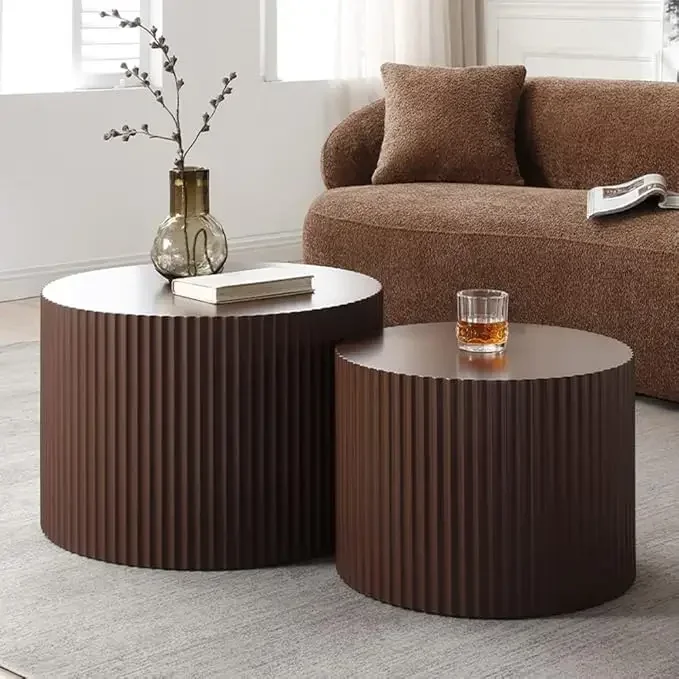
For those looking to incorporate iconic teak elements into their own homes, understanding how to identify quality pieces becomes essential. Whether considering vintage originals or contemporary designs that reference classic elements, certain indicators help distinguish exceptional tables from mere imitations.
Weight provides one of the most immediate quality indicators when evaluating teak coffee tables. Substantial pieces typically weigh between 30-45 pounds (13.5-20.5 kg), reflecting solid construction and genuine teak (which is denser than many substitute woods). When examining quality nesting designs, lift each piece to assess its heft – lightweight tables often indicate thinner materials or alternative woods stained to mimic teak’s appearance.
Construction details reveal much about a piece’s quality and authenticity. Examine drawer operation closely – quality drawers should slide smoothly with minimal effort and stop cleanly without slamming. Check grain matching across surfaces and edges – superior pieces feature thoughtfully aligned patterns rather than random transitions. Inspect joinery points for tight fits without excessive glue or filler. These small details collectively indicate the care invested in creating the piece.
Mid-Century Modern Solid Wood Coffee Tables, Mid-Century Modern Teak Coffee Tables
$879.95 Select options This product has multiple variants. The options may be chosen on the product pageMid-Century Modern Danish Coffee Tables, Mid-Century Modern Oval Coffee Tables, Mid-Century Modern Solid Wood Coffee Tables
$390.05 Select options This product has multiple variants. The options may be chosen on the product pageMid-Century Modern Coffee & End Table Sets, Mid-Century Modern Coffee Table Sets, Mid-Century Modern Oval Coffee Tables
Price range: $257.48 through $331.04 Select options This product has multiple variants. The options may be chosen on the product pageMid-Century Modern Glass Top Coffee Tables, Mid-Century Modern Glass Top Side & End Tables
$460.58 Select options This product has multiple variants. The options may be chosen on the product pageMid-Century Modern Glass Top Coffee Tables, Mid-Century Modern Vintage Coffee Tables, Mid-Century Modern Vintage Side & End Tables
$725.36 Select options This product has multiple variants. The options may be chosen on the product pageMid-Century Modern Lift Top Coffee Tables, Mid-Century Modern Square Coffee Tables
$454.73 Select options This product has multiple variants. The options may be chosen on the product page
Finish quality significantly affects both appearance and longevity. Quality teak pieces feature even application without drips, bubbles, or inconsistent sheen. Hand-rubbed finishes create a subtle luster that enhances teak’s natural beauty without creating an artificial plastic-like surface. Run your hand across the wood – even with protective finishes, you should feel a connection to the natural material rather than just a coating.
When considering authentic mid-century styles, pay attention to proportional relationships between elements. Authentic designs feature carefully considered ratios between top thickness, leg dimensions, height, and surface area. These relationships create visual harmony that distinguishes thoughtful design from casual imitation. The exemplary designs to consider demonstrate these balanced proportions that contribute to their iconic status.
Remember that iconic teak coffee tables don’t exist in isolation – they should complement your broader interior style. The versatility of these pieces allows them to enhance various design approaches, from minimalist contemporary spaces to eclectic collected interiors. Their clean lines and warm natural tones make them remarkably adaptable while still making a distinct design statement.
How to Care for Iconic Teak Pieces: Preserving Design Legacy
Proper maintenance ensures that teak coffee tables continue to be enjoyed for generations, preserving both their beauty and their historical significance. Different approaches to care can either maintain original finishes or allow the development of teak’s celebrated patina.
For regular cleaning, a simple approach works best. Use a soft cloth dampened with a mild soap solution (approximately 1 tablespoon per gallon/15ml per 3.8 liters of water) to gently remove dust and minor soiling. Avoid harsh chemicals that can damage finishes or strip teak’s natural oils. For more stubborn spots, a soft brush with natural bristles can help clean grain patterns without scratching surfaces.
Decisions about finish maintenance depend on personal preference and the table’s original condition. Some owners prefer to preserve the original honey-gold color using specialized teak oil applied every 3-6 months. Others embrace the natural silvery-gray patina that develops over time, which many consider part of teak’s unique character and appeal. Either approach can be appropriate, depending on the specific piece and your aesthetic preferences.
Environmental considerations significantly impact teak furniture longevity. Maintain moderate humidity levels (ideally 40-60% relative humidity) to prevent excessive drying or moisture absorption. Position tables away from direct sunlight, which can cause uneven fading, and maintain distance from heating vents or radiators that create localized drying. These simple precautions prevent common issues like cracking or warping.
For minor damage, gentle restoration approaches preserve design integrity. Small scratches often respond well to careful application of teak oil or specialized furniture wax. Deeper scratches may require fine sandpaper (starting with 220 grit and progressing to 320 or finer), always sanding with the grain rather than against it. For vintage pieces with historical significance, consult with a professional restorer before attempting repairs to avoid diminishing value or authenticity.
These maintenance tips for long-term enjoyment help ensure that iconic teak coffee tables continue to bring beauty and function to living spaces for decades to come, honoring their design legacy while providing ongoing utility.
Beyond the Living Room: The Versatility of Iconic Teak Tables
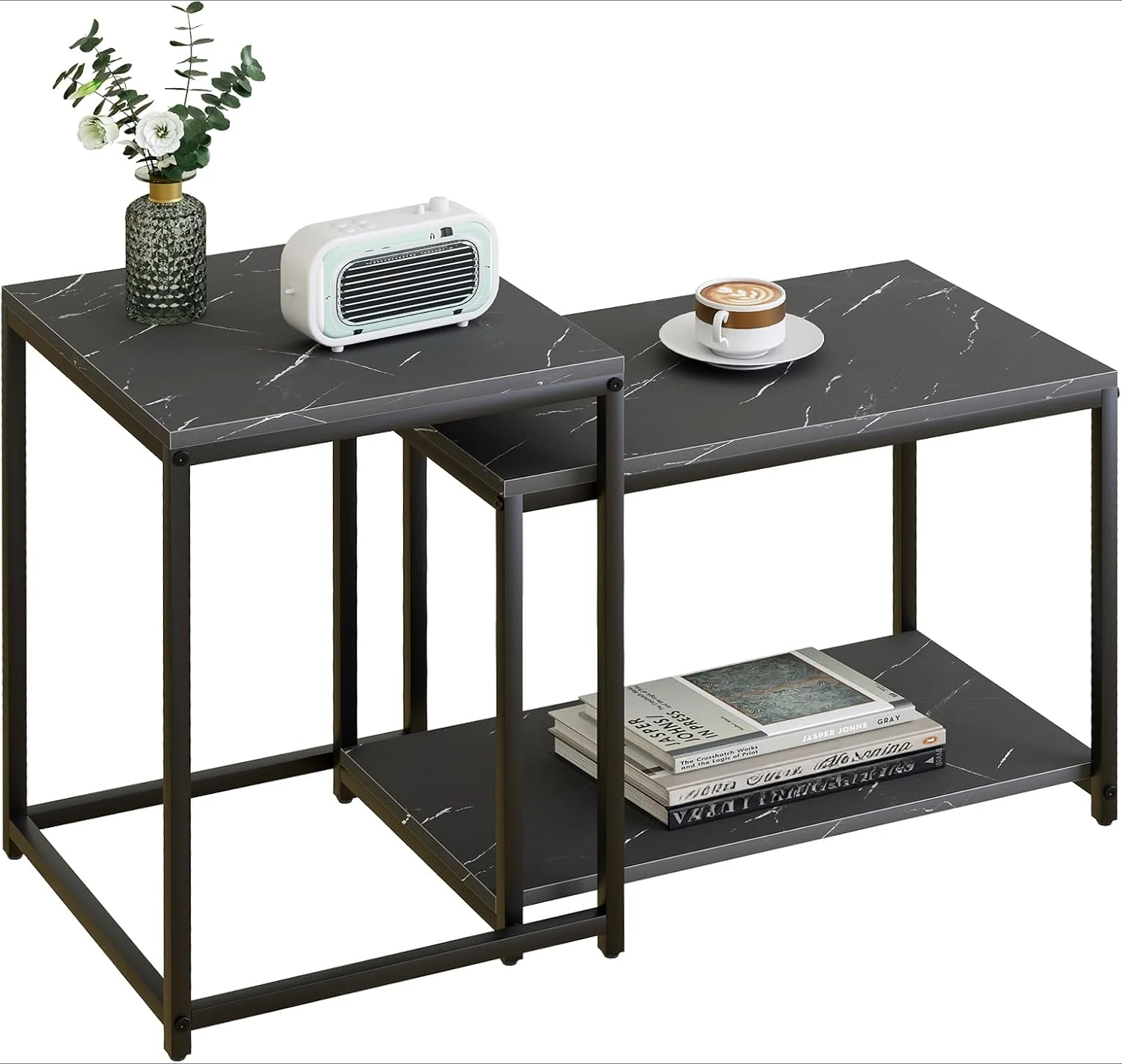
While coffee tables were originally designed for living room settings, the versatility of iconic teak pieces allows them to function beautifully in various contexts throughout the home. This adaptability demonstrates the enduring relevance of thoughtful design that transcends its intended purpose.
In open-concept spaces, teak coffee tables can serve as elegant room dividers that define functional areas without interrupting visual flow. Their modest height creates gentle boundaries rather than barriers, while their beautiful finish ensures they look appropriate from any angle. This dual-facing quality makes them particularly valuable in contemporary floor plans where traditional walls have been removed.
As remote work becomes increasingly common, many homeowners have discovered that teak coffee tables can function admirably as workspace surfaces. Their comfortable height for seated use, durable finishes, and generous surfaces make them natural desks for laptops or writing. Some designs with storage elements provide perfect spaces for organizing work materials that can be quickly concealed when work hours end.
In bedroom settings, teak coffee tables find new purpose as multi-functional surfaces and style statements. Placed at the foot of a bed, they create convenient spaces for books, decorative objects, or morning coffee. Their lower height complements bed height while providing useful surface area without the bedroom-furniture formality of traditional blanket chests or benches.
For appropriate designs and climates, covered outdoor areas can showcase the weather-resistant qualities that made teak famous in shipbuilding. Under protected patios or porches, teak coffee tables withstand humidity variations while bringing sophisticated style to outdoor living spaces. Their natural resistance to moisture and insects makes them particularly well-suited to these transitional environments.
These varied applications demonstrate why versatile walnut designs and teak pieces continue to find new admirers in each generation. Their fundamental quality, thoughtful proportions, and material excellence allow them to transcend their original context, finding new relevance in evolving living spaces. This adaptability – perhaps more than any other quality – explains why these iconic designs continue to feel contemporary despite their historical origins.
The legacy of iconic teak coffee tables extends far beyond their material composition or specific design features. They represent a philosophy of living that values quality over quantity, thoughtfulness over trendiness, and lasting beauty over momentary impact. In our increasingly disposable culture, these enduring pieces remind us that good design transcends time – continuing to bring function, beauty, and meaning to our everyday environments.

